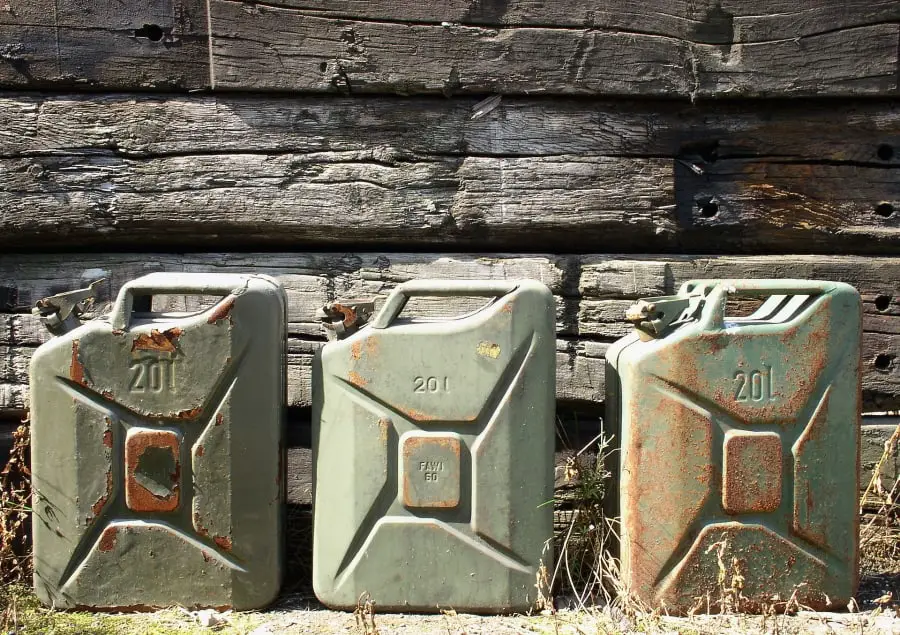Too much of anything is a bad thing.
This time-old saying clearly recommends the use of moderation (or the instructions on the back of the label). Can the same extend to the use of chemical agents in lawnmower maintenance?
Though adding too much fuel stabilizer in a mower is not bad per se, it is not recommended to exceed the levels the manufacturer recommends on the product packaging. Though excessive levels can cause clogged carburetors or engine corrosion over time, it is not likely.
That’s what we’ll be looking at today, as we discuss fuel stabilizers and the best way to use them. Some people might think, “more ‘stabilizer’, more ‘stability’”, but is that really the case? Are there any problematic consequences and, more importantly, solutions?

Contents
Can You Use Too Much Fuel Stabilizer In Your Mower?
The relatively infrequent use of private lawnmowers, coupled with the need to put them away during harsh winters, means machines that run on gas and diesel may retain fuel for very long time. This leads to the need for a stabilizer, but can this be overdone?
You can use too much fuel stabilizer in your lawn mower, but the results are normally not dire and in some cases not noticeable. It can clog carburetors and cause corrosion over extended periods of time, but over adding fuel stabilizer normally will just waste stabilizer.
This doesn’t mean that you should just pour in stabilizer into any amount of fuel without measuring. There are specific properties that it has and with the right mixture it can add months or even a year to the storage life of most gas and diesel fuels.
Why Should You Use Fuel Stabilizer?
The trouble with storing fuel in machinery or even containers for long periods is the series of chemical reactions and re-reactions that lead to the overall degradation of the fuel, as essential components escape through evaporation.
Fuel stabilizers in lawn mowers or in any gas tank for that matter, lengthen the time you can store gasoline or diesel before degrading makes the fuel unusable in combustion engines. It also stops sedimentation that creates particles capable of clogging carburetors.
In addition to degrading the fuel itself, the reactions can have a corrosive effect on the container (or fuel tank) the fuel is stored in. This may result in the chipping away of particles from the container, which adds to the already existing sedimentation in the fuel.
These particles can clog up near vital spots in your fuel system or engine, which is bad news.
While these reactions are much faster in gasoline, diesel fuel cannot be stored forever either.
So, ultimately, this reactivity and sedimentation means that combustion fuels are not stable…and that’s where fuel stabilizer comes in.
How Much Fuel Stabilizer Should You Use In Your Mower?
Fuel stabilizer is a chemical agent that drastically slows these reactions down while destroying particles that would otherwise be harmful to the mower’s fuel tank or fuel system. This makes the fuel much more storable over extended periods (several months to a few years, depending on the type).
A typical recommended mixture of fuel stabilizer is one ounce to two and a half gallons of fuel. Usually, the label on the stabilizer container has mixing instructions you can follow. You can mix the stabilizer in the gas tank on the machine itself or in a separate container.
I recommend that you carry out the mixture in a canister, or some other measuring container, so you can be sure of your fuel and stabilizer volumes before you add the mix.
Can You Use Too Much Fuel Stabilizer?
So, now we are back to our original question. If there are recommended amounts to use when mixing with gasoline and diesel, is it possible to use too much?
Exceeding the recommended mixture levels of fuel stabilizer to gasoline is generally not a good idea because the consequences may vary. However, in almost all cases, using too much stabilizer is simply a waste of good fuel stabilizer. It will not be harmful in the short term.
A little definitely goes a long way and it is not unheard of for a bottle of stabilizer to last years due to sparing use.
Some long term effects of too much stabilizer could include carburetor blockage and even corrosion, although these usually depend on the specific brand of stabilizer used as well as the quantity.
So, all in all, while adding too much stabilizer is not the end of the world, it’s best to stick to the specified mixing instructions, or to consult a professional.
Want to see more articles about mowers? I recommend my others here…
- I Put The Wrong Fuel In My Lawn Mower: Here’s How To Fix It
- What Kind Of Gas To Put In A Lawn Mower
- Is It Safe To Store A Lawn Mower In The Garage?
What Happens If Too Much Fuel Stabilizer Is In Your Mower?
There are always mistakes, and I am definitely not the exception. I have added 2 cycle oil mixtures twice to the same gas can before realizing it and I am sure I have done the same thing with fuel stabilizers. So, what would be the result if you did this in your mower?
In most cases, nothing will happen if you put too much stabilizer in your lawnmower. Most brands of stabilizer won’t do anything besides reduce the rate of the fuel’s chemical reactions. Diluting gasoline or diesel with other elements will always take away from combustion levels, if only slightly.
However, in some cases, this can lead to the clogging of vital carburetor components, which can affect the combustion process and, ultimately, the performance of the mower.
The wrong mixture can even lead to corrosion of parts of the mower’s fuel and engine systems, particularly if you are using a de-varnishing stabilizer. This corrosion can even result in fuel leakages in some areas.
Fortunately, such effects are unlikely to occur if you miss the recommended mark by a few ounces.
What To Do If You Add Too Much Fuel Stabilizer In A Mower?
If you happen to go over the recommended volume of fuel stabilizer, do not panic, as there are solutions for various scenarios.
If 4 to 5 ounces over recommended levels of fuel stabilizer are added to a mower’s gas tank, no action needs to be taken. If 6 ounces or more are added over the limit, immediately run it until the tank is empty. The tank only needs to be manually emptied if an anti-varnish stabilizer was used.
If you missed the mark by a few ounces (e.g., 5 ounces instead of one), there’s not really any need to do anything unless you notice an effect on the mower’s performance. Just run the mower as you normally would and avoid repeating the mistake.
If you mixed the fuel with a lot of stabilizer, there is a risk that the carburetor may get clogged. You will have to run the mower as usual and carefully note how it performs.
In cases where an anti-varnish stabilizer has been used, the fuel tank should be emptied immediately to minimize any damage to the fuel system. The fuel lines, in particular, are especially thin, which makes them susceptible to leaks if they get thinned out any further.
How To Empty Anti-Varnish Fuel Stabilizer From A Mower Gas Tank
Emptying the mower fuel tank is a fairly simple process. Let’s look at the steps to take in case a large amount of anti-varnish fuel stabilizer somehow ends up in your mower.
You can either use a siphoning pump or a pair of hoses to empty nearly any mower gas tank.
If you don’t have a siphoning pump, I recommend this one from Amazon.
Emptying A Mower Gas Tank With A Siphoning Pump
- You start by placing the mower on a flat, and paved surface to avoid spilling any fuel on your lawn.
- If you are using a siphoning pump, stick one end in the tank and the other in an empty fuel collection canister.
- Start the siphoning pump to start the drainage and collect the fuel.
- Once the pump is no longer able to siphon out any more fuel, you will have to add more fuel to dilute any remaining stabilizer.
Emptying A Lawn Mower Gas Tank Without A Siphoning Pump
If you do not have access to a siphoning pump, you can use two hoses to blow out the unwanted fuel-stabilizer mix.
- Simply place one long hose into the tank, making sure that the end is submerged.
- The other end of the long hose must go into your collection canister.
- Next, place a shorter hose into the tank, but keep that end above the fuel level.
- The other end should just stick out of the tank.
- Then, using a damp cloth, seal the fuel tank opening and leave the two hoses as the only out/inlets.
- Next, you must blow into the short hose to increase pressure in the tank, which forces the fuel-stabilizer mix to move up the long hose and into the canister.
- Again, add more fuel once the siphoning is over.
What To Do With Fuel Mixed With Stabilizer After Removal
Once you’ve collected the fuel, you must inspect it to see if it is actually usable. If it is, you can dilute it with more fuel to remove the excess stabilizer.
Otherwise, you will have to dispose of the mix safely. Do not dump it, as the law frowns on that. Also, do not dump it on your lawn because this will kill the grass and even affect soil fertility.
The Final Touches On Using Too Much Fuel Stabilizer In Your Mower…
Is it bad to use too much fuel stabilizer in a lawn mower? Not really, no. As long as you don’t use more stabilizer than fuel and it isn’t an anti-varnish type of stabilizer, you should be fine. If you use a ton of extra in a mixture and it is already in the mower tank, you should just run the mower until the tank is empty without letting it sit.
The only real reason to manually empty a tank with a siphoning pump or the DIY tube method is if anti-varnish is present in the mixture.
Hopefully this help put your worries to rest.
If you would like to read more helpful articles, I recommend seeing my other articles…
- I Put The Wrong Fuel In My Lawn Mower: Here’s How To Fix It
- What Kind Of Gas To Put In A Lawn Mower
- Is It Safe To Store A Lawn Mower In The Garage?
References
